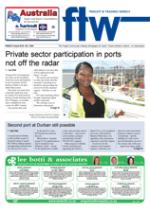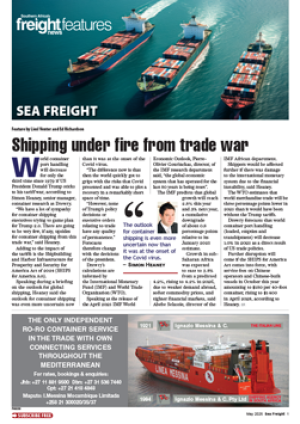While restful visions of full
ships, no debt and robust
bottom lines will elude ship
operators for a while yet,
AP Moller-Maersk, world’s
largest container shipping
group, realises full well a key
component in the road back to
profitability is forging longterm
customer contracts.
None of this three-month,
six-month stuff, but three
of even more years, is the
symbiotic thinking of Eivind
Kolding and Tomas Dyrbye,
CEOs of Maersk Line and
Safmarine respectively.
Kolding, speaking at the
JOC Transpacific Maritime
Conference in the USA
recently, said long-term
contracts were a more
constructive alternative
to shippers hedging rate
fluctuations through the
new-fangled container
derivatives, “a potential
casino,” in his view.
He argues contracts (of the
shorter kind) have tended not
to be honoured historically
and that longer-term contracts
will enable the lines to
improve reliability and reduce
transaction costs for shippers.
Apprised of Kolding’s
California comments, Dyrbye,
thousands of kilometers
away in Cape Town on his
second official visit to South
Africa since assuming office
recently, agrees emphatically.
“Most of the customers I
have spoken to at Safmarine
also agree that volatility in
the marketplace is a very big
problem for all.
”In our industry, contracts
don’t have that many legally
binding commitments and
what we are seeing in some
instances is that when the
market goes up customers
stand firm on a rate but
when it goes down, they
suddenly don’t.
“Many contracts are for
perhaps three months, not
even covering a full calendar
year, and what we would like
to see is contracts of one to
three years, even longer.”
The AP Moller-Maersk
Group lost US$1 billion
overall last year. Freight rates
for the Group’s container
activities were 28% lower
than in 2008, resulting in a
negative segment result of
US$ 2.1 billion for container
activities. Dyrbye is not
telling how much Safmarine
lost, though he concedes
its losses were less than the
considerably bigger
Maersk Line.
Safmarine’s new East
Africa Mashariki Express
service launched on March 2
is a clear acknowledgement
that the line needed to up its
service offering in the region
but that is where it stops,
certainly for now.
“At this very moment, it’s
about restoring profitability,
so we don’t have any plans
for West or South Africa.
“We must be able to
produce a profit this year and
a decent profit next year.”
The AP Moller-Maersk
connection has clearly
benefited Safmarine, volume
growth since the takeover in
1999 up from 180 000 to
800 000 FFEs, which has
enabled the carrier and the
group to further stamp their
presence on Africa, a
core business.
In the process, says Dyrbye,
Safmarine has really become
more of a global than a South
African player. Indeed many
decisions taken nowadays are
of a global nature.
A source of pride is the
remarkable growth of the
Safmarine newbuild fleet
programme, seven ships slated
for delivery this year and
next, to swell the fleet to
27 owned ships by 2015.
“A great achievement,”
says Dyrbye.
Long-term contracts the key to carrier profitability
09 Apr 2010 - by Ray Smuts
0 Comments
FTW - 9 Apr 10

09 Apr 2010
09 Apr 2010
09 Apr 2010
09 Apr 2010
09 Apr 2010
09 Apr 2010
Border Beat
Featured Jobs
New
New
New
